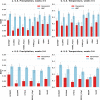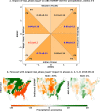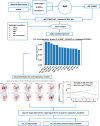Adaptive bias correction for improved subseasonal forecasting
- PMID: 37321988
- PMCID: PMC10272189
- DOI: 10.1038/s41467-023-38874-y
Adaptive bias correction for improved subseasonal forecasting
Abstract
Subseasonal forecasting-predicting temperature and precipitation 2 to 6 weeks ahead-is critical for effective water allocation, wildfire management, and drought and flood mitigation. Recent international research efforts have advanced the subseasonal capabilities of operational dynamical models, yet temperature and precipitation prediction skills remain poor, partly due to stubborn errors in representing atmospheric dynamics and physics inside dynamical models. Here, to counter these errors, we introduce an adaptive bias correction (ABC) method that combines state-of-the-art dynamical forecasts with observations using machine learning. We show that, when applied to the leading subseasonal model from the European Centre for Medium-Range Weather Forecasts (ECMWF), ABC improves temperature forecasting skill by 60-90% (over baseline skills of 0.18-0.25) and precipitation forecasting skill by 40-69% (over baseline skills of 0.11-0.15) in the contiguous U.S. We couple these performance improvements with a practical workflow to explain ABC skill gains and identify higher-skill windows of opportunity based on specific climate conditions.
© 2023. The Author(s).
Conflict of interest statement
The authors declare no competing interests.
Figures








References
-
- Troccoli A. Seasonal climate forecasting. Meteorol. Appl. 2010;17:251–268. doi: 10.1002/met.184. - DOI
-
- Merryfield WJ, et al. Current and emerging developments in subseasonal to decadal prediction. Bull. Am. Meteorol. Soc. 2020;101:E869–E896. doi: 10.1175/BAMS-D-19-0037.1. - DOI
-
- White CJ, et al. Potential applications of subseasonal-to-seasonal (S2S) predictions. Meteorol. Appl. 2017;24:315–325. doi: 10.1002/met.1654. - DOI
-
- National Academies of Sciences Engineering and Medicine. in Next Generation Earth System Prediction: Strategies for Subseasonal to Seasonal Forecasts (The National Academies Press, Washington, DC, 2016).
-
- Mariotti A, et al. Windows of opportunity for skillful forecasts subseasonal to seasonal and beyond. Bull. Am. Meteorol. Soc. 2020;101:E608–E625. doi: 10.1175/BAMS-D-18-0326.1. - DOI
MeSH terms
Grants and funding
LinkOut - more resources
Full Text Sources

